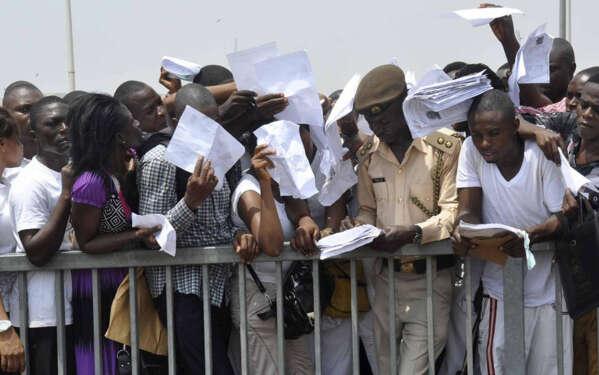Nigeria’s unemployment rate has risen to 33.3% in Q4, 2020.
The rate rose from 27.1% recorded as of Q2 2020, indicating that about 23,187,389 Nigerians remain unemployed.
According to the recently released labour force report published by the National Bureau of Statistics (NBS), the underemployment rate decreased from 28.6% to 22.8%.
The statistics show a combination of both the unemployment and underemployment rate for the reference period gave a figure of 56.1%.
This means that 33.3% of the labour force in Nigeria or 23,187,389 persons either did nothing or worked for less than 20 hours a week, making them unemployed.
This is an additional 1,422,772 persons from the number in that category in Q2, 2020. Using the international definition of unemployment, the rate was computed to be 17.5%.
Education
According to the report, those reporting A ‘levels as their highest qualification had the highest rate of unemployment with 50.7%, followed by those with first degree/HND at 40.1%.
Those with Doctorate Degrees as their highest qualifications reported the lowest rate of unemployment, 16.9% during the reference period.
Age
Under the age-groupings, the highest rate of unemployment was recorded among the 15-24-year age-group with 53.4%, followed by those aged between 25-34 with 37.0%, together the youth population recorded an unemployment rate of 42.5%.
In the case of underemployment by age grouping, those aged between 55-64 recorded an underemployment rate of 25.7%, the highest amongst the age groups.
Also Read: Online betting: Ghana to introduce new policy to curb revenue leakages
This was followed by those aged between 45-54 with 24.4%, while those with the lowest underemployment rate were those aged between 15-24 with 19.8%.
A combination of unemployment and underemployment rates shows that those aged between 15-24 reported a combined rate of 73.2%, showing a serious challenge for the age-group in secure full-time employment.
Gender
Female unemployment was highest among the genders with 35.2% while the male was 31.8% during the reference period.
A similar case was recorded for underemployment, 24.2% was reported for females, while males reported an under-employment rate of 21.8%.
The unemployment rate among rural dwellers was 34.5%, while urban dwellers reported a rate of 31.3%. In the case of underemployment, rural dwellers reported a rate of 26.9%, while the rate among urban dwellers was 16.2%.
Unemployment and Underemployment by State
In the case of unemployment by state, Imo State recorded the highest rate of unemployment with 56.64%. This was followed by Adamawa with 54.89% and Cross Rivers State with 53.65%.
The States with the lowest rates were Osun, Benue and Zamfara States with 11.65%, 11.98% and 12.99% respectively.
In the case of underemployment, Benue State recorded the highest rate with 43.52%, followed by Zamfara and Jigawa States with 41.73% and 41.29% respectively.
Also Read: Ghana petitions ECOWAS over Benin’s duty regime
Combining both unemployment and underemployment, the state that recorded the highest rate was Imo with 82.5% followed by Jigawa with 80%.
Ogun and Sokoto states recorded the lowest of the combined rates, 26.2% and 33.7% respectively.
International rate
Nigeria’s recent unemployment rate is 17.5%.
Comparing this rate internationally, out of 181 countries with rate published within the last 2 years, Nigeria currently ranks as the 19th country with the highest unemployment rate.
The countries with the highest unemployment rates presently are Bosnia and Herzegovinian (33.7%), Namibia (33.4%), and South Africa (32.5%) while those with the lowest rates are Qatar (0.1%), Belarus (0.2%), Niger (0.3%) and Myanmar (0.7%).
It is important to note that reference periods and methodology of calculating the unemployment rate could differ across the countries.
Therefore, a direct comparison of the unemployment rate in different countries may not be valid.
Labour force
The number of persons in the labour force (i.e., people within ages 15 -64, who are able and willing to work) was estimated to be 69,675,468.
This was 13.22% less than the number of persons in Q2, 2020. Of this number, those within the age bracket of 25-34 were highest, with 20,091,695 or 28.34% of the labour force.
This is the estimated number of persons within the economically active population or working population, that are available and willing to work.
This implies that as of Q4 2020, only 57.09% of Nigeria’s economically active population are in the labour force.
Unlike in the economically active population, the age group that accounts for the highest number under the labour force is the 25-34 age group.
This is expected as most persons within the age group of 15-24 are involved in one form of schooling or the other, hence are not willing and/or available for work.
While females are more dominant under the active population, albeit marginal, the reverse holds for the labour force, where males are more dominant with 56.72%, with females accounting for 43.28%.
